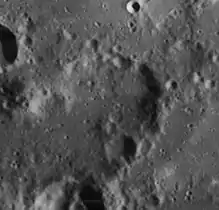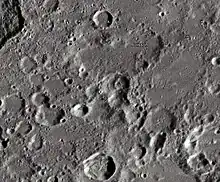 Lunar Orbiter 4 image | |
| Coordinates | 30°24′S 10°36′E / 30.4°S 10.6°E |
|---|---|
| Diameter | 42 km |
| Depth | 2.0 km |
| Colongitude | 350° at sunrise |
| Eponym | Siméon Denis Poisson |
Poisson is a lunar impact crater that is located in the southern highlands of the Moon's near side. It was named after French mathematician Siméon Denis Poisson.[1] It lies to the east of the crater Aliacensis and northwest of Gemma Frisius. To the northwest of Poisson is Apianus.
This heavily eroded crater shares a common floor with the satellite crater Poisson T to the west-southwest, and the two craters have more or less merged into a single formation with a narrower neck in between. The rim of Poisson is heavily eroded, and is overlain by several craters. Poisson U is intruding into the southern rim at the junction of Poisson and Poisson T. A low-walled formation is joined to the northern rim at the opposite side of the neck from Poisson U.
The interior floor of Poisson and Poisson T has been resurfaced by basaltic lava, leaving a level surface within the inner walls. A pair of old, worn craters lies along the inner wall in the southeast part of the crater.
Satellite craters

By convention these features are identified on lunar maps by placing the letter on the side of the crater midpoint that is closest to Poisson.
| Poisson | Latitude | Longitude | Diameter |
|---|---|---|---|
| A | 29.6° S | 9.1° E | 17 km |
| B | 30.8° S | 10.9° E | 11 km |
| C | 33.1° S | 8.6° E | 26 km |
| D | 31.4° S | 7.7° E | 12 km |
| E | 34.2° S | 8.6° E | 14 km |
| F | 33.7° S | 8.0° E | 14 km |
| G | 31.7° S | 7.4° E | 16 km |
| H | 33.0° S | 7.4° E | 19 km |
| J | 35.0° S | 8.3° E | 27 km |
| K | 32.7° S | 9.6° E | 13 km |
| L | 32.7° S | 8.2° E | 16 km |
| M | 33.9° S | 7.6° E | 7 km |
| N | 30.7° S | 8.4° E | 4 km |
| O | 35.0° S | 9.1° E | 4 km |
| P | 31.9° S | 8.9° E | 7 km |
| Q | 32.6° S | 10.2° E | 28 km |
| R | 30.0° S | 8.4° E | 5 km |
| S | 29.9° S | 11.4° E | 4 km |
| T | 31.1° S | 9.2° E | 25 km |
| U | 31.6° S | 10.3° E | 25 km |
| V | 32.0° S | 10.6° E | 16 km |
| W | 29.6° S | 11.9° E | 3 km |
| X | 29.0° S | 12.3° E | 5 km |
| Z | 29.6° S | 10.5° E | 5 km |
References
- ↑ "Poisson (crater)". Gazetteer of Planetary Nomenclature. USGS Astrogeology Research Program.
- Andersson, L. E.; Whitaker, E. A. (1982). NASA Catalogue of Lunar Nomenclature. NASA RP-1097.
- Bussey, B.; Spudis, P. (2004). The Clementine Atlas of the Moon. New York: Cambridge University Press. ISBN 978-0-521-81528-4.
- Cocks, Elijah E.; Cocks, Josiah C. (1995). Who's Who on the Moon: A Biographical Dictionary of Lunar Nomenclature. Tudor Publishers. ISBN 978-0-936389-27-1.
- McDowell, Jonathan (July 15, 2007). "Lunar Nomenclature". Jonathan's Space Report. Retrieved 2007-10-24.
- Menzel, D. H.; Minnaert, M.; Levin, B.; Dollfus, A.; Bell, B. (1971). "Report on Lunar Nomenclature by the Working Group of Commission 17 of the IAU". Space Science Reviews. 12 (2): 136–186. Bibcode:1971SSRv...12..136M. doi:10.1007/BF00171763. S2CID 122125855.
- Moore, Patrick (2001). On the Moon. Sterling Publishing Co. ISBN 978-0-304-35469-6.
- Price, Fred W. (1988). The Moon Observer's Handbook. Cambridge University Press. ISBN 978-0-521-33500-3.
- Rükl, Antonín (1990). Atlas of the Moon. Kalmbach Books. ISBN 978-0-913135-17-4.
- Webb, Rev. T. W. (1962). Celestial Objects for Common Telescopes (6th revised ed.). Dover. ISBN 978-0-486-20917-3.
- Whitaker, Ewen A. (1999). Mapping and Naming the Moon. Cambridge University Press. ISBN 978-0-521-62248-6.
- Wlasuk, Peter T. (2000). Observing the Moon. Springer. ISBN 978-1-85233-193-1.